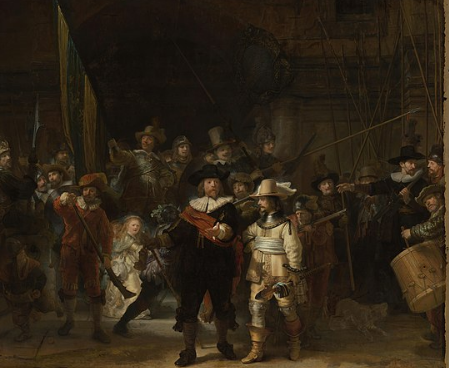1. GIRL WITH A PEARL EARRING

Artist: Johannes Vermeer
Date: 1665
Where to see it: Mauritshuis, The Hague, Netherlands (https://www.mauritshuis.nl)
“Girl with a pearl earring” is the most renowned painting of Johannes Vermeer, a prominent Dutch Golden Age master. The work is considered one of the most famous pieces of Baroque art and is often called ‘Mona Lisa of the North’.
The painting depicts a young girl with an exotic blue and yellow turban and a pearl earring. It features the use of dramatic and chiaroscuro lighting, and the contrast between the girl and the dark background draws attention to her glowing skin and pearl earring.
“Girl with a pearl earring” was not popular during his day, and was even lost for over 200 years. The painting’s fame today is partly thanks to Tracy Chevalier’s bestselling novel of the same title, fictionizing the life of the girl behind the creation of Vermeer’s masterpiece. The novel was later adapted into a film with the same title, earning three Academy Award nominations.
2. THE NIGHT WATCH

Artist: Rembrandt van Rijn
Date: 1642
Where to see it: Rijksmuseum, Amsterdam (https://www.rijksmuseum.nl)
“The Night Watch” is the most renowned and largest painting by Rembrandt van Rijn. The official version of the title is “Militia Company of District II Under the Command of Captain Frans Banninck Cocq”. However, the dark impression due to a thick layer of varnish misled viewers into thinking that it depicted a night scene, hence the name.
“The Night Watch” is a group portrait of a company of civic guardsmen. Instead of painting a group of city guards in neat rows or at a banquet, Rembrandt depicted them in a moment of moving into action with the masterful use of chiaroscuro and dramatic movement.
The central focus is Captain Cocq and Lieutenant Ruytenburch, surrounded by other militiamen and a young girl. Rembrandt’s mastery is apparent in the manipulation of light, directing focus onto specific figures and creating a sense of movement.
3. LAS MENINAS

Artist: Diego Velázquez
Date: 1656
Where to see it: Museo Nacional del Prado, Madrid
“Las Meninas”, painted by Diego Velázquez, is one of the most influential works in Western art history. The painting is a Baroque marvel that defies traditional portraiture, portraying a scene in the royal court of King Philip IV of Spain. Housed in the Museo del Prado, Madrid, it features a complex composition with several figures, most notably Infanta Margarita Teresa, the daughter of King Philip IV at its center, and Velázquez himself featured as the artist standing brush-in-hand in front of a large canvas.
What makes the painting unique is Velázquez’s skillful manipulation of perspective and reflection. The artist challenges the viewer’s perception by placing a mirror in the background, reflecting the king and queen. The work blurs the boundaries between reality and representation, inviting contemplation on the nature of art and the relationship between the viewer, the artist, and the subjects.
4. THE CALLING OF SAINT MATTHEW

Artist: Michelangelo Merisi da Caravaggio
Date: 1600
Where to see it: San Luigi dei Francesi, Rome
“The Calling of Saint Matthew” is an oil painting by the famous Italian painter Michelangelo Merisi da Caravaggio. It was painted for the Contarelli Chapel in the church of San Luigi dei Francesi in Rome. It hangs alongside two other paintings by Caravaggio:”The Martyrdom of Saint Matthew” and “The Inspiration of Saint Matthew”.
The work depicts the moment Jesus Christ calls on the tax collector Matthew to follow him and become one of his apostles. It employs a single source of light illuminating the dim space from behind Christ, purposely coinciding with the small window. The light aligns with Christ’s gaze and extended hand, directing attention towards the figures in the dark room. This painting displays Caravaggio’s mastery in chiaroscuro and tenebrism techniques influencing painters all over Europe known as Caravaggism.
5. RAPE OF THE DAUGHTERS OF LEUCIPPUS

Artist: Peter Paul Rubens
Date: 1618
Where to see it: Alte Pinakothek, Munich
“The Rape of the Daughters of Leucippus” by Peter Paul Rubens, painted around 1618, is a masterpiece of Baroque art. The work depicts a dramatic scene from Greek mythology where the twin brothers Castor and Pollux abduct Phoebe and Hilaeira, daughters of Leucippus.
Rubens captures the moment with dynamic composition and dramatic movement. The composition is marked by swirling movement, intense emotions, and vibrant colors, showcasing the artist’s mastery of the Baroque style. “The Rape of the Daughters of Leucippus” stands as a testament to Rubens’ artistic prowess and his contribution to the grandeur and theatricality of Baroque painting.
